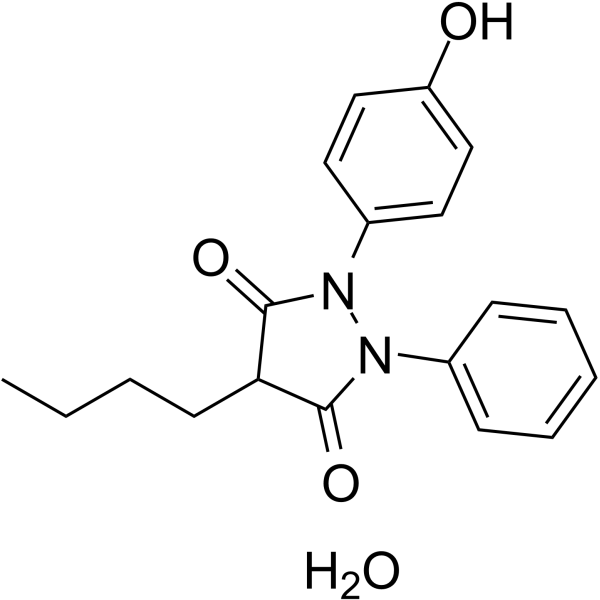7081-38-1
| 中文名 | 羟基保泰松 |
|---|---|
| 英文名 | oxyphenbutazone hydrate |
| 中文别名 | 羟保泰松 |
| 英文别名 |
oxyphenbutazon monohydrate
OXYPHENBUTAZONE HYDRATE OXYPHENBUTAZONE MONOHYDRATE OXYPHENYL BUTAZONE MONOHYDRATE Unii-H806S4B3ns |
| 描述 | 一水合氧苯丁酮是苯丁酮(HY-B0230)的代谢物,具有抗炎作用。一水合氧苯丁酮是一种口服活性非选择性COX抑制剂。一水合氧苯丁酮选择性地杀死非复制性结核分枝杆菌[1][2]。 |
|---|---|
| 相关类别 | |
| 靶点 |
COX, Bacteria[1][2] |
| 体外研究 | 氧苯丁酮增强甲氨蝶呤(MTX)(HY-14519)在Hep3B细胞中的抗癌效率[1]。氧苯丁酮(2.5-7.5µM;48小时)与(MTX,0.25-1.0µM)共同处理显示出对Hep3B细胞的潜在细胞毒性[1]。氧苯丁酮对肝细胞具有修复作用[1]。细胞活力测定[1]细胞株:Hep3B细胞浓度:2.5µM、5µM和7.5µM培养时间:48小时结果:增强了MTX的细胞毒性。 |
| 体内研究 | 当与MTX(5.0或2.5 mg/kg/week;i.p.)联合治疗时,氧苯丁酮(70 mg/kg/we周;p.o.;分两次服用;持续13周)具有潜在的抗癌活性[1]。动物模型:Wistar系白化雄性大鼠(5-6周;150-220 g)[1]剂量:70 mg/kg/周(与MTX 5.0或2.5 mg/kg/星期共同治疗)给药:PO;一周一次分两次服用;结果:与甲氨蝶呤联合治疗大鼠,发挥了潜在的抗癌活性。 |
| 参考文献 |
| 沸点 | 485.6ºC at 760 mmHg |
|---|---|
| 熔点 | 96°; mp 124-125° |
| 分子式 | C19H22N2O4 |
| 分子量 | 342.38900 |
| 闪点 | 247.5ºC |
| 精确质量 | 342.15800 |
| PSA | 70.08000 |
| LogP | 3.55910 |
| 储存条件 | 2-8°C |
|
Version 1.2
Regulation (EC) No 1907/2006 1 - Product and Company Information Product NameOXYPHENBUTAZONE HYDRATE 2 - Hazards Identification SPECIAL INDICATION OF HAZARDS TO HUMANS AND THE ENVIRONMENT Harmful if swallowed. Irritating to eyes and skin. Limited
evidence of a carcinogenic effect. May cause sensitization by inhalation and skin contact. 3 - Composition/Information on Ingredients Product NameCAS #EC noAnnex I Index Number OXYPHENBUTAZONE HYDRATE7081-38-1 NoneNone FormulaC19H20N2O3 Molecular Weight 324,4000 AMU 4 - First Aid Measures AFTER INHALATION If inhaled, remove to fresh air. If not breathing give artificial respiration. If breathing is difficult, give oxygen. AFTER INGESTION If swallowed, wash out mouth with water provided person is conscious. Call a physician. 5 - Fire Fighting Measures EXTINGUISHING MEDIA Suitable: Water spray. Appropriate foam. SPECIAL PROTECTIVE EQUIPMENT FOR FIREFIGHTERS Wear self-contained breathing apparatus and protective clothing to prevent contact with skin and eyes. 6 - Accidental Release Measures SIGMAwww.molbase.com PROCEDURE(S) OF PERSONAL PRECAUTION(S) Wear self-contained breathing apparatus, rubber boots, and heavy rubber gloves. METHODS FOR CLEANING UP Sweep up, place in a bag and hold for waste disposal. Avoid raising dust. Ventilate area and wash spill site after material pickup is complete. 7 - Handling and Storage HANDLING Directions for Safe Handling: Do not breathe dust. Do not get in eyes, on skin, on clothing. Avoid prolonged or repeated exposure. STORAGE Conditions of Storage: Keep tightly closed. Store in a cool dry place. Store at 2-8°C 8 - Exposure Controls / Personal Protection ENGINEERING CONTROLS Safety shower and eye bath. Mechanical exhaust required. GENERAL HYGIENE MEASURES Wash thoroughly after handling. Wash contaminated clothing before reuse. PERSONAL PROTECTIVE EQUIPMENT Special Protective Measures: Wear appropriate government approved respirator, chemical-resistant gloves, safety goggles, other protective clothing. 9 - Physical and Chemical Properties AppearancePhysical State: Solid PropertyValueAt Temperature or Pressure pHN/A BP/BP RangeN/A MP/MP RangeN/A Flash PointN/A FlammabilityN/A Autoignition TempN/A Oxidizing PropertiesN/A Explosive PropertiesN/A Explosion LimitsN/A Vapor PressureN/A Partition CoefficientN/A ViscosityN/A Vapor DensityN/A Saturated Vapor Conc.N/A Evaporation RateN/A Bulk DensityN/A Decomposition Temp.N/A Solvent ContentN/A Water ContentN/A SIGMAwww.molbase.com Surface TensionN/A ConductivityN/A Miscellaneous DataN/A SolubilityN/A 10 - Stability and Reactivity STABILITY Stable: Stable. HAZARDOUS DECOMPOSITION PRODUCTS Hazardous Decomposition Products: Carbon monoxide, carbon dioxide, and nitrogen oxides. HAZARDOUS POLYMERIZATION Hazardous Polymerization: Will not occur 11 - Toxicological Information SENSITIZATION Sensitization: May cause allergic reaction. SIGNS AND SYMPTOMS OF EXPOSURE To the best of our knowledge, the chemical, physical, and toxicological properties have not been thoroughly investigated. Fever, sore throat, lesions in the mouth, symptoms of anemia, unusual bleeding or bruising, dyspepsia, epigastric pain, black or tarry stools or other evidence of intestinal ulceration, skin rashes, significant weight gain, edema, optic neuritis, superficial ulceration of the cornea, conjunctivitis, blurred vision, retinal hemorrhage, toxic amblyopia, retina detachment, agranulocytosis, aplastic anemia, liver and kidney damage. Stomach pains, vomiting, diarrhea. Exposure can cause: ROUTE OF EXPOSURE Skin Absorption: May be harmful if absorbed through the skin. Inhalation: May be harmful if inhaled. Material may be irritating to mucous membranes and upper respiratory tract. Ingestion: Harmful if swallowed. Multiple Routes: Causes eye and skin irritation. TARGET ORGAN INFORMATION Thyroid. Liver. Kidneys. Bone marrow. G.I. System. Blood. 12 - Ecological Information No data available. 13 - Disposal Considerations SUBSTANCE DISPOSAL Dissolve or mix the material with a combustible solvent and burn in a chemical incinerator equipped with an afterburner and scrubber. Observe all federal, state, and local environmental regulations. 14 - Transport Information RID/ADR Non-hazardous for road transport. SIGMAwww.molbase.com IMDG Non-hazardous for sea transport. IATA Non-hazardous for air transport. 15 - Regulatory Information CLASSIFICATION AND LABELING ACCORDING TO EU DIRECTIVES INDICATION OF DANGER: Xn Harmful. R-PHRASES: 22-36/38-40-42/43 Harmful if swallowed. Irritating to eyes and skin. Limited evidence of a carcinogenic effect. May cause sensitization by inhalation and skin contact. S-PHRASES: 22-26-36 Do not breathe dust. In case of contact with eyes, rinse immediately with plenty of water and seek medical advice. Wear suitable protective clothing. Caution: Substance not yet fully tested (EU). COUNTRY SPECIFIC INFORMATION Germany WGK: 3 Self-Classification 16 - Other Information DISCLAIMER For R&D or manufacturing use. Not for prescription compound or other uses. SIGMAwww.molbase.com SECTION 16 - ADDITIONAL INFORMATION N/A |
| 危害码 (欧洲) | Xn |
|---|---|
| 风险声明 (欧洲) | 22-36/38-40-42/43 |
| 安全声明 (欧洲) | 22-26-36 |

